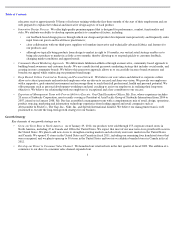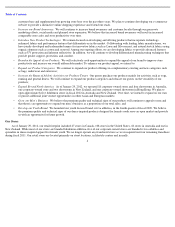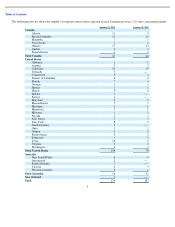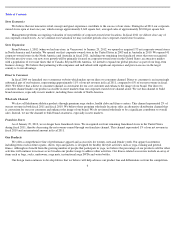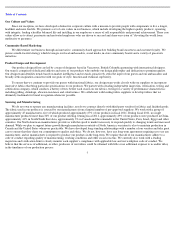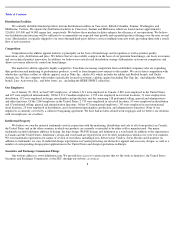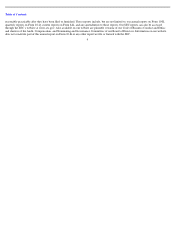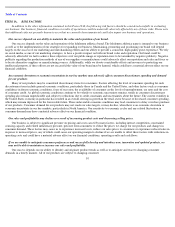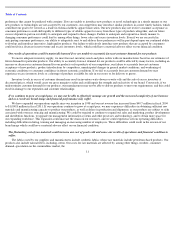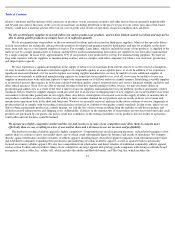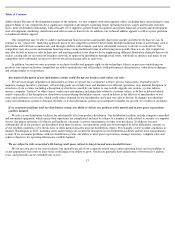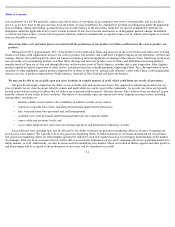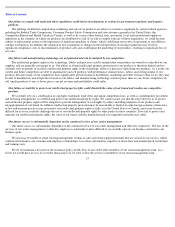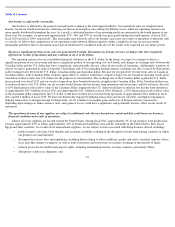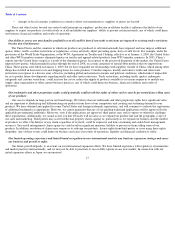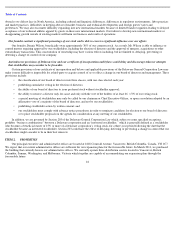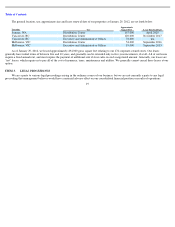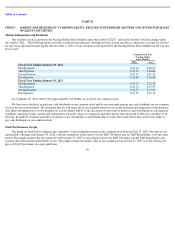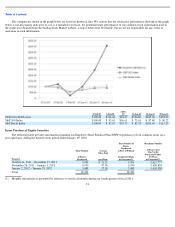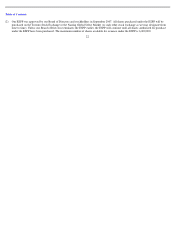Lululemon 2011 Annual Report Download - page 15
Download and view the complete annual report
Please find page 15 of the 2011 Lululemon annual report below. You can navigate through the pages in the report by either clicking on the pages listed below, or by using the keyword search tool below to find specific information within the annual report.
Table of Contents
relative valuations and fluctuations of the currencies of producer versus consumer countries and other factors that are generally unpredictable
and beyond our control. Increases in the cost of raw materials, including petroleum or the prices we pay for our cotton yarn and cotton-based
textiles, could have a material adverse effect on our cost of goods sold, results of operations, financial condition and cash flows.
We rely on third-party suppliers to provide fabrics for and to produce our products, and we have limited control over them and may not be
able to obtain quality products on a timely basis or in sufficient quantity.
We do not manufacture our products or the raw materials for them and rely instead on third-party suppliers. Many of the specialty fabrics
used in our products are technically advanced textile products developed and manufactured by third parties and may be available, in the short-
term, from only one or a very limited number of sources. For example, Luon fabric, which is included in many of our products, is supplied to the
mills we use by a single manufacturer in Taiwan, and the fibers used in manufacturing Luon fabric are supplied to our Taiwanese manufacturer
by a single company. In fiscal 2011, approximately 67% of our products were produced by our top five manufacturing suppliers. We have no
long term contracts with our suppliers or manufacturing sources, and we compete with other companies for fabrics, raw materials, production
and import quota capacity.
We may experience a significant disruption in the supply of fabrics or raw materials from current sources or, in the event of a disruption,
we may be unable to locate alternative materials suppliers of comparable quality at an acceptable price, or at all. In addition, if we experience
significant increased demand, or if we need to replace an existing supplier manufacturer, we may be unable to locate additional supplies of
fabrics or raw materials or additional manufacturing capacity on terms that are acceptable to us, or at all, or we may be unable to locate any
supplier or manufacturer with sufficient capacity to meet our requirements or to fill our orders in a timely manner. Identifying a suitable supplier
is an involved process that requires us to become satisfied with their quality control, responsiveness and service, financial stability and labor and
other ethical practices. Even if we are able to expand existing or find new manufacturing or fabric sources, we may encounter delays in
production and added costs as a result of the time it takes to train our suppliers and manufacturers in our methods, products and quality control
standards. Delays related to supplier changes could also arise due to an increase in shipping times if new suppliers are located farther away from
our markets or from other participants in our supply chain. Any delays, interruption or increased costs in the supply of fabric or manufacture of
our products could have an adverse effect on our ability to meet customer demand for our products and our results in lower net revenue and
income from operations both in the short and long term. We have occasionally received, and may in the future continue to receive, shipments of
products that fail to comply with our technical specifications or that fail to conform to our quality control standards. In that event, unless we are
able to obtain replacement products in a timely manner, we risk the loss of net revenue resulting from the inability to sell those products and
related increased administrative and shipping costs. Additionally, if defects in the manufacture of our products are not discovered until after such
products are purchased by our guests, our guests could lose confidence in the technical attributes of our products and our results of operations
could suffer and our business could be harmed.
We operate in a highly competitive market and the size and resources of some of our competitors may allow them to compete more
effectively than we can, resulting in a loss of our market share and a decrease in our net revenue and profitability.
The market for technical athletic apparel is highly competitive. Competition may result in pricing pressures, reduced profit margins or lost
market share or a failure to grow our market share, any of which could substantially harm our business and results of operations. We compete
directly against wholesalers and direct retailers of athletic apparel, including large, diversified apparel companies with substantial market share
and established companies expanding their production and marketing of technical athletic apparel, as well as against retailers specifically
focused on women’s athletic apparel. We also face competition from wholesalers and direct retailers of traditional commodity athletic apparel,
such as cotton T-shirts and sweatshirts. Many of our competitors are large apparel and sporting goods companies with strong worldwide brand
recognition, such as Nike, Inc., adidas AG, which includes the adidas and Reebok brands, and The Gap, Inc, which includes the
12



